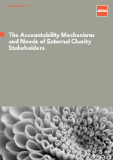Connolly, Dhanani, and Hyndman, May 2013. This report reviews the top 100 UK fundraising charities and the accountability information they make available to stakeholders.
ACCA research report no. 132
by
Ciaran Connolly
Queen’s University Belfast
Alpa Dhanani
Cardiff University
Noel Hyndman
Queen’s University Belfast

RESEARCH OBJECTIVES
Despite the widespread acceptance that charities should discharge accountability to their external stakeholders, there is limited knowledge of their information needs (in particular, the needs of charity donors, who are identified in earlier research as a key stakeholder group to whom accountability is owed and whether the information being disclosed is aligned with these needs). Through extensive document analysis, surveys of various stakeholder groups and a number of semi-structured interviews with key actors, the main aims of the present study were to identify:
- the accountability information made available publicly to charity stakeholders
- stakeholder needs for such information, and
- the perceptions of key providers of information about stakeholder information needs.
RESEARCH METHODS
This report focuses on the top 100 UK fundraising charities (as ranked by Caritas Data), because they are economically significant and have a high national and international profile. These charities are also likely to be the trendsetters in the sector and have sufficient resources to engage in innovation. A mixture of quantitative and qualitative research methods were used to address the key research questions.
To identify the accountability information made available publicly to charity stakeholders, 99 annual reports, 53 annual reviews and 92 Summary Information Returns (SIRs) of the top 100 UK fundraising charities for 2007/8 were analysed (the year immediately preceding the year in which the research reported here commenced). To allow comparisons to be made over time, Hyndman’s checklist (1990, 1991) of 14 information types, amended as required for changing terminology, was used. This list contained a mixture of the information types that were identified as important by charity donors and those that were most frequently disclosed by charities in Hyndman’s (1990) study.
In addition, an anonymous online questionnaire was developed to gather, among other things, information about key stakeholders, the relative importance of well-established channels of communication and the information needs, as perceived by themselves and others, of stakeholders. In total, 228 respondents from four key stakeholder groups (beneficiaries, charity officials, donors and external auditors) completed the questionnaire. This included definitions of key terms and examples of charity disclosures, and was tailored to take consideration of the differing circumstances of each of the respondent groups.
Finally, in order to obtain a more in-depth understanding of the issues, and enrich the findings of the document analysis and the online questionnaire, interviews were undertaken with stakeholders drawn from each of the key stakeholder groups. The questions asked were informed by the themes arising out of the literature review and the findings from the content analysis and online questionnaire. In total, 26 interviews were conducted.


